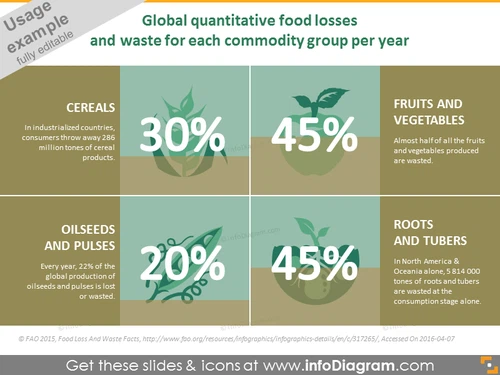Global quantitative food losses and waste
from deck
Food and Agriculture icons bundle: Animals, Crop Cultivation, Forestry (PPT flat clipart)
- Info
- How To Edit
- Usage example
Info
Global quantitative food losses and waste for each commodity group per year
Slide Content
The PowerPoint slide presents statistics on the food losses and waste percentages for various commodity groups, a critical issue in global sustainability. "CEREALS" shows a 30% loss where consumers in industrialized countries discard 286 million tons of cereal products, highlighting significant wastage in staple foods. With "FRUITS AND VEGETABLES," the waste is more alarming at 45%, denoting that nearly half the produce is thrown away. For "OILSEEDS AND PULSES," the waste is at 20%, which signifies that a fifth of the global production of these crops is lost or wasted. The "ROOTS AND TUBERS" section also shows a 45% waste, particularly pointing out that over five million tons in North America and Oceania are wasted just at consumption.
Graphical Look
- The slide is divided into four equal sections, each one with a different pastel background color.
- In the center of each section is a large percentage figure in bold, white font, indicating the food loss and waste percentage.
- Each section has a specific title that sits at the top in black text within a white rectangle.
- Iconography is used effectively with a plant-based motif for each commodity to represent "CEREALS," "FRUITS AND VEGETABLES," "OILSEEDS AND PULSES," and "ROOTS AND TUBERS."
- Below the icons and percentage figures, there is a small explanatory text box that provides context about the food loss and waste statistics.
The overall look of the slide is clean and modern, with a focus on visual hierarchy to present statistical information clearly and effectively. The use of colors, icons, and large text works together to create an engaging visual summary of the data.
Use Cases
- Presenting in a conference on food sustainability to highlight areas where waste reduction could be impactful.
- Used in education or training sessions to discuss the implications of food waste and how to manage it more effectively.
- As part of a business or NGO presentation to justify investment into food preservation technology or processes.
- Applicable during policymaking or strategic planning meetings involving agricultural sectors or food supply chain management.
How To Edit
How to edit text & colors

How to expand / shorten diagram

How to Replace Icons in infoDiagram PPT


